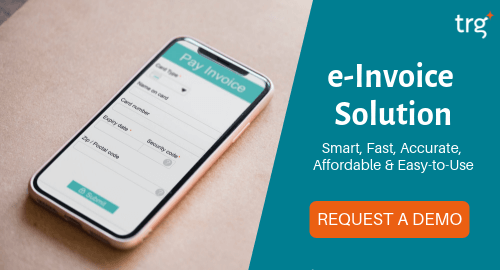Electronic invoicing (e-invoicing) is revolutionising how businesses handle transactional documents between suppliers and buyers. From cost reduction and automation to improved cash flow and enhanced relationships, e-invoicing offers a wide range of advantages while also helping to contribute to environmental sustainability by reducing paper usage and minimising the carbon footprint.
In this article, we will explore the various benefits of e-invoicing for both suppliers and buyers, highlighting the positive impact it has on efficiency, profitability, and the environment.
Read more: Poor Cash Flow, Overdue Payments Thwart Your Accounts Receivable Processes?

Contents
What is electronic invoicing?
Electronic invoicing (e-invoicing) is the transmission, reception, and processing of digital transactional documents between suppliers and buyers. A true e-invoicing method should be entirely electronic in such a way that data from the supplier can be integrated directly into the buyer’s system.
A scanned invoice in Adobe PDF format sent via email, for instance, is not a true e-invoice. While it may appear digital, it still requires additional data re-entry, which can be both time-consuming and prone to mistakes. This manual input not only increases the chances of errors but also slows down the overall invoicing process.
Read more: Must-have Features of E-invoicing Software
Benefits of e-invoicing at a glance
E-invoicing offers a wide range of benefits that go beyond just cost reduction. Let's take a closer look at how e-invoicing positively impacts businesses and the environment.
Reduce costs
E-invoicing significantly reduces costs by eliminating the need for paper-based processes. Businesses can save on printing, postage, and storage expenses. Moreover, manual data entry is minimised, reducing the likelihood of errors and the need for costly rectification.
Facilitate automation
With electronic invoicing systems, businesses can streamline their invoicing processes, reducing the time and effort required for manual tasks, thus increasing efficiency and freeing up valuable resources that can be allocated to more strategic activities.
Read more: 3 Pressing Challenges for the Hotel Accounting Team in Today’s Digital Age
Shorten payment cycles
The traditional invoicing process can be time-consuming, leading to payment delays and cash flow issues. E-invoicing accelerates the entire payment process, ensuring that suppliers receive their funds on time, which not only improves relationships between suppliers and buyers but also enhances overall business productivity.
Improve account reconciliation
With paper-based invoices, reconciling accounts can be a laborious and error-prone task. E-invoicing systems automate this process, ensuring accurate and real-time data synchronisation between the buyer and supplier, thus saving time and reducing the risk of discrepancies and disputes for both parties.
Enhance compliance
In many industries, businesses must adhere to strict regulations and reporting requirements. E-invoicing systems can help ensure compliance, simplify processes, and minimise the risk of penalties or legalities by providing clear audit trails, secure transmission of invoices, and accurate record-keeping.
Prevent errors, losses and fraud
Manual invoicing processes are susceptible to mistakes and fraud, leading to financial losses. E-invoicing eliminates these risks by providing secure and traceable transactions, reducing the likelihood of errors and fraud.
Read more: 7 Worst Financial Fiascos Caused by Excel Errors
Improve supplier/ customer relationship
By offering a seamless and efficient invoicing experience, businesses can build trust and loyalty with their suppliers and customers. Prompt payments, accurate invoices, and transparent communication contribute to a positive business relationship that can lead to long-term partnerships and mutual growth.
Reduce the carbon footprint
Paper-based invoicing requires significant resources, including trees, water, and energy. By transitioning to e-invoicing, businesses can help protect the environment by reducing paper consumption and minimising the carbon emissions associated with the manufacturing, transportation, and disposal of paper documents.
Benefits of e-invoicing for suppliers
1. Faster payment and improved cash flow
Upon receiving paper or PDF invoices from the supplier, the buyer has to sort, route, rekey, and submit the invoices for approval. This process not only takes time but also increases the possibility of losing invoices.
Conversely, e-invoices are immediately accessible on the buyer’s system and can be routed and approved much faster, thus ultimately leading to on-time payments and improved cash flow.
Read more: Poor Cash Flow, Overdue Payments Thwart Your Accounts Receivable Processes?
2. Better account reconciliation
The reconciliation of invoices issued to customers against the payments received is one of the challenges every supplier faces. Customers can combine multiple invoices into one single payment. On top of that, such payment amounts might vary from the original invoices, for instance, customers claiming deductions due to damaged goods.
A supplier may issue five invoices of $2,000 each but may receive a $9,000 single payment. This leads to the need to contact the customer’s Accounts Payable department to clarify payment details.
With e-invoicing, customers can send the details of the invoices along with the payments to help simplify account reconciliation.
Read more: Solving 5 Common Accounts Payable Issues with Automation
3. Reduced costs
For suppliers, the adoption of e-invoicing helps significantly reduce costs associated with printing, storage, processing, and delivery of paper invoices. Printing and postage can quickly add up for suppliers who deal with a large volume of invoices.
Additionally, the reduced need for manual data entry and the increased accuracy of e-invoicing means fewer customer service calls are required to rectify errors or discrepancies. This not only saves time for suppliers but also reduces the cost of maintaining a customer service team to handle invoice-related queries.
4. Fewer disputes and rejected invoices
Resolving invoice disputes and rejections is costly, time-consuming, and can lead to late payments.
With e-invoicing, data from the supplier’s Accounts Receivable (AR) system is transferred directly to the customer’s AP system, lowering the risk of errors caused by data re-entry. Therefore, the potential for invoices to be rejected is reduced.
5. Improved customer satisfaction
Thanks to e-invoicing’s faster processing and fewer payment issues, suppliers can provide a higher level of customer service.
With e-invoicing, invoices are electronically transmitted and seamlessly integrated into the buyer's system, eliminating the need for manual data entry and reducing the chances of errors and delays. This efficient and automated process ensures that invoices are processed and paid on time, enhancing the overall customer experience.
As a result, suppliers can provide a higher level of customer service, ultimately leading to a higher rate of customer retention, trust, loyalty, and long-term and mutually beneficial relationships.
Read more: Common Accounts Payable Problems and the Changing Role of the Accounts Payable function
Benefits of e-invoicing for buyers
1. Increased productivity and automation
For paper or PDF invoices, the documents must be stored, sorted, and re-entered into the AP (accounts payable) system. These steps, especially data re-entry, are inherently time-consuming and prone to error.
With e-invoicing, data is sent directly from the supplier to the buyer’s AP system, eliminating the need for manual data re-entry. As a result, accounting staff can devote more time to high-value activities.
E-invoicing enables AP departments to automatically validate invoices before they are routed to the line of business managers for approval. These validations ensure that all the calculations, such as VAT (GST) amounts, are correct. They also aid in identifying which departments are purchasing which goods.
Read more: Automating Reporting in the Financial Services Sector: a Case Study
They also match the invoices with other procurement documents, such as contracts and purchase orders. For instance, the prices on the invoice must match those in the contract. The goods’ descriptions must match those on the PO and goods receipt.
Such validations can now be performed automatically with e-invoicing.
Because data entry and validation are automated, there is less need for the buyer’s staff to call the supplier to confirm the receipt of invoices or make inquiries about the details.
The benefits of e-invoicing for buyers are greatly enhanced if the e-invoicing solution comes equipped with a supplier portal. It enables suppliers to track the status of invoices as well as approval and payment information. Suppliers can see if their invoices have been received, approved, and submitted for payment. As a result, the need for follow-up calls is markedly reduced.
2. Reduced costs
Thanks to the reduction, or even complete elimination, of manual data re-entry, sorting, validation, and registration of invoices, e-invoicing can deliver substantial cost savings of 60 to 80 per cent.
3. Take advantage of early payment discounts
Suppliers are often willing to offer a discount in exchange for an early payment. E-voicing allows for faster processing and, hence, shorter payment cycles. As a result, buyers who use e-invoices have more access to discount opportunities.
4. Improved supplier relationship
A fast, efficient payment method can potentially help buyers strengthen their relationships with suppliers, which can translate into a more streamlined supply chain and improved customer satisfaction.
Are you looking to digitalise your invoicing and payment processes to lessen the workload of your finance team? Save time and effort and instead focus more on strategic activities that truly matter with the right solution. Share your concerns with us and see how TRG's e-invoice solution can help your team and business shine by requesting a demo today!
 English
English  Vietnamese
Vietnamese 



